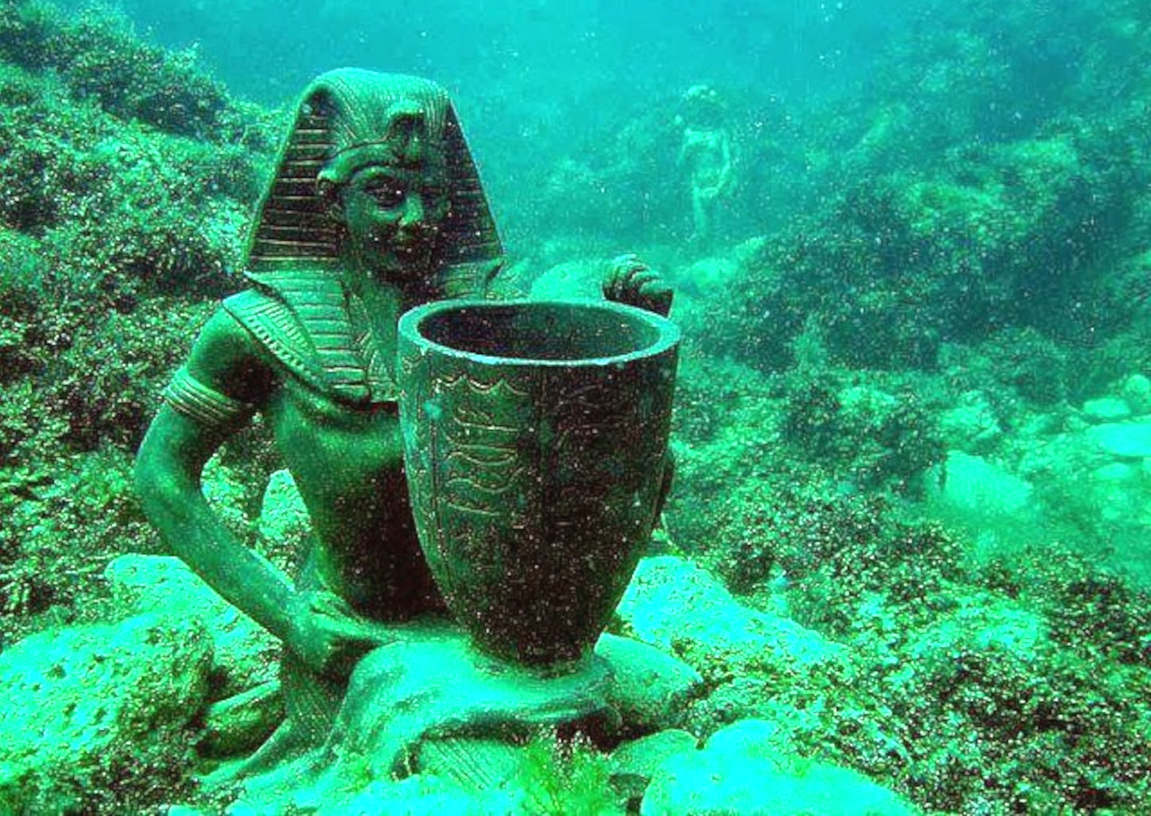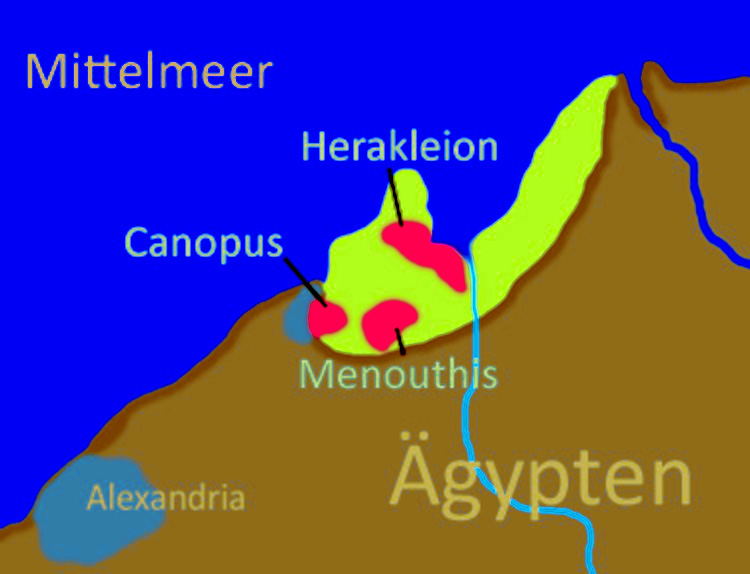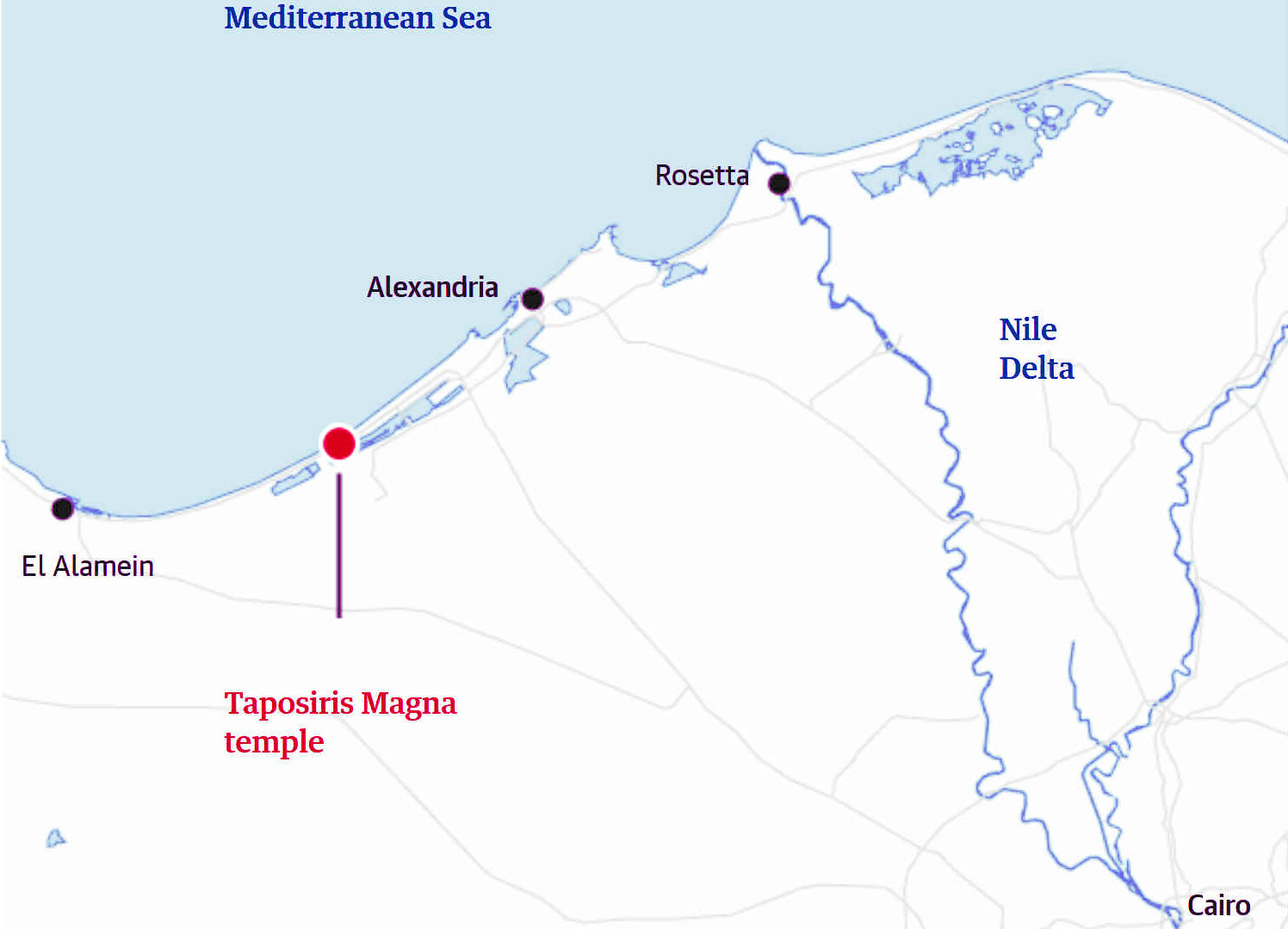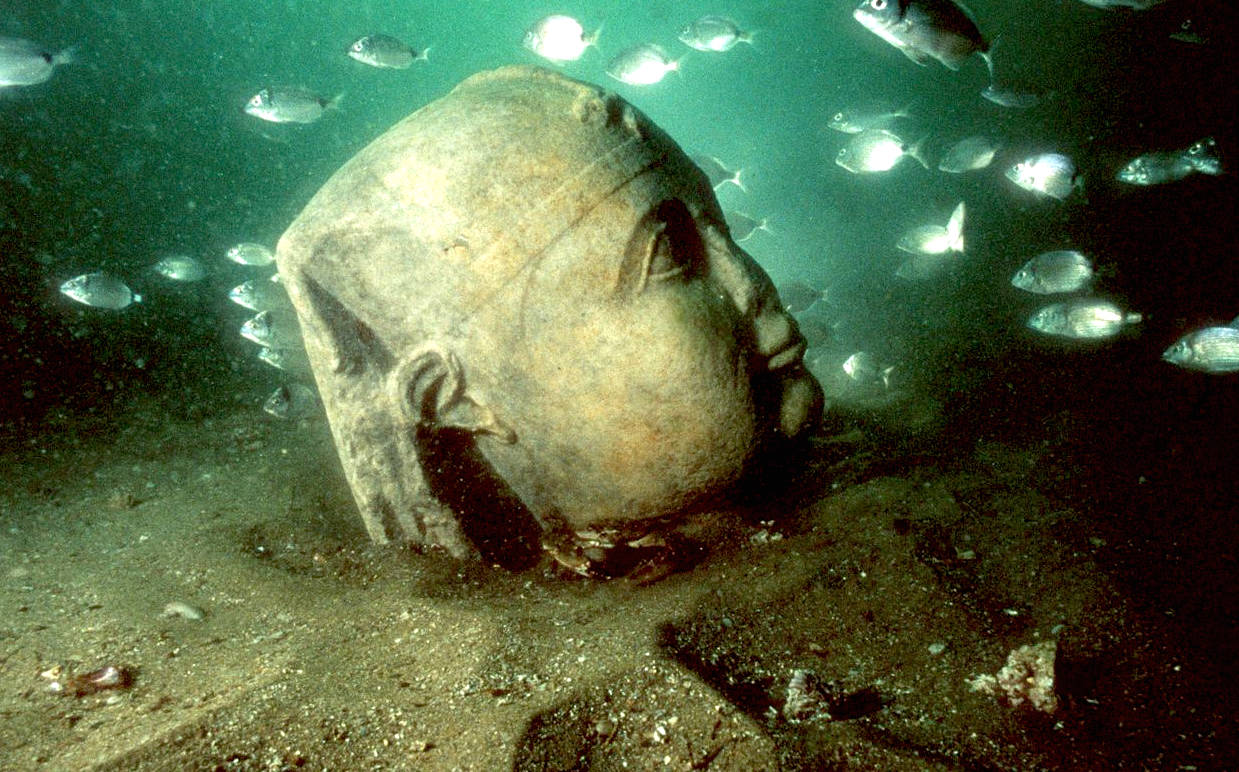|

Canopus (Coptic:
Ⲕⲁⲛⲱⲡⲟⲥ, Kanopos; Greek: Κάνωπος, Kanōpos), also known as Canobus (Greek: Κάνωβος, Kanōbos), was an ancient Egyptian coastal town, located in the
Nile Delta. Its site is in the eastern outskirts of modern-day
Alexandria, around 25 kilometers (16 mi) from the center of that city. Canopus was located on the western bank at the mouth of the westernmost branch of the Delta – known as the Canopic or Heracleotic branch. It belonged to the seventh Egyptian Nome, known as Menelaites, and later as Canopites, after it. It was the principal port in Egypt for Greek trade before the foundation of Alexandria, along with Naucratis and Heracleion. Its ruins lie near the present Egyptian town of Abu Qir.
Land in the area of Canopus was subject to rising sea levels, earthquakes, tsunamis, and large parts of it seem to have succumbed to liquefaction sometime at the end of the 2nd century BC. The eastern suburbs of Canopus collapsed, their remains being today submerged in the
Mediterranean
sea, with the western suburbs being buried beneath the modern coastal city of Abu Qir.
HISTORY - ANCIENT EGYPT
Canopus was the site of a temple to the Egyptian god Serapis.
The name of Canopus appears in the first half of the 6th century BC in a poem by Solon. Early Egyptological excavations some 2 or 3 km from the area known today as Abu Qir have revealed extensive traces of the city with its quays, and granite monuments with the name of Ramesses II, but they may have been brought in for the adornment of the place at a later date. The exact date of the foundation of Canopus is unknown, but Herodotus refers to it as an ancient port. Homeric myth claims that it was founded by Menelaus, and named after Canopus, the pilot of his ship, who died there after being bitten by a serpent. Legend describes how Menelaus built a monument to his memory on the shore, around which the town later grew up. There is unlikely to be any connection with "canopy". A temple to Osiris was built by king Ptolemy III Euergetes, but according to Herodotus, very near to Canopus was an older shrine, a temple of Heracles that served as an asylum for fugitive slaves.
Osiris was worshipped at Canopus under a peculiar form: that of a vase with a human head. Through an old misunderstanding, the name "canopic jars" was applied by early Egyptologists to the vases with human and animal heads in which the internal organs were placed by the Egyptians after embalming.
HELLENISTIC PERIOD
In Ptolemy III Euergetes' ninth regnal year (239 BC), a great assembly of priests at Canopus passed an honorific decree (the "Decree of Canopus") that, inter alia, conferred various new titles on the king and his consort, Berenice. Three examples of this decree are now known (plus some fragments), inscribed in Egyptian (in both hieroglyphic and demotic) and in classical Greek, and they were second only to the more famous Rosetta Stone in providing the key to deciphering the ancient Egyptian language. This was the earliest of the series of bilingual inscriptions of the "Rosetta Stone Series", also known as the Ptolemaic Decrees. There are three such Decrees altogether.
The town had a large trade in henna.
ROMAN PERIOD
In Roman times, the town was notorious for its dissoluteness. Seneca wrote of the luxury and vice of Canopus, though he also mentioned that "Canopus does not keep any man from living simply". Juvenal's Satire VI referred to the "debauchery" that prevailed there. The emperor Hadrian built a villa at Tivoli, 18 miles away from Rome, where he replicated for his enjoyment architectural patterns from all parts of the Roman Empire. One of these (and the most excavated and studied today) was borrowed from
Canopus.

ARCHAEOLOGY
Over time the land around Canopus was weakened by a combination of earthquakes, tsunamis and rising sea levels. Finds of pottery and coins appear to stop at the end of the 2nd century BC. At this point, probably after a severe flood, the eastern suburbs succumbed to liquefaction of the soil on which it was built. The hard clay turned rapidly into a liquid and the buildings
collapsed. The western suburbs eventually became the present day Egyptian coastal city of Abu
Qir.
In 1933 ruins were sighted under the water by an RAF commander who was flying over
Abu Qir
Bay. Egyptian scholar Prince Omar Toussoun subsequently undertook archaeological investigations between 1934 and 1940. The undersea ruins were eventually identified as the lost cities of Heracleion and Canopus.
In 2000 the French underwater archaeologist Franck Goddio explored the submerged ruins of the two cities. Archaeological discoveries made by Goddio's team included parts of the "Naos of the Decades" temple and pieces of various statues, including a marble head of the god Serapis.
The ancient city of Canopus is mentioned many times by classical authors and the fathers of the church. The oldest mention of Canopus can be found in a poem by Solon, from the first half of the 6th century BC. According to the poet Nicander (2nd century BC), Menelaus’ helmsman, Canopus, died here, bitten by a viper on the sands of Thonis. The city located close by was named after this unfortunate sailor: Canopus. During the last Pharaonic dynasties and the Ptolemaic period, Canopus was famous for its sanctuaries of Osiris and
Serapis. Pilgrims from all over the world came to visit in search of miraculous healing.
Throughout the existence of the grand sanctuary of Herakles in Heracleion, the God
Osiris was taken from here on his ritual barque to his sanctuary in Canopus. This procession created a mystical tie between the two neighbouring cities. During Roman times Canopus was condemned in literature for its extravagant feasts, however, attracting many visitors. Emperor Hadrian, in order to keep alive the memories of the good times he enjoyed in Canopus, even had a replica of part of Canopus built at Villa Hadriana outside Rome. After the destruction of the temples by Christian iconoclasts, the construction of a powerful monastery followed. It became famous for holding the relics of Saint John and Saint Cyril. Those relics brought to the monastery the same powers for miraculous healings as the former pagan temple of Osiris-Serapis and consequently the site continued to be a place of pilgrimage.
The fate of the eastern suburbs of Canopus was identical to that which befell Thonis-Heracleion: the sea repossessed these places with their rich histories.

Two kilometres to the east of the modern port of
Aboukir, the IEASM have identified a zone that contains numerous archaeological remains, including some that clearly corresponded to those discovered by Prince Toussoun in 1933. This site consists of a row of ruins 150 metres long. Broken shafts of columns of red granite are combined with limestone construction blocks and other architectural elements. Artefacts, including jewels, crosses, coins and seals of the Byzantine Period, were found during the IEASM investigations here. To the north of these structures, under almost two metres of sand, are the well-preserved foundations of a wall that measures 103 metres long. It is suggested that this wall would have surrounded a temple, which from the scale of the wall would be the largest Egyptian shrine found thus far in the region.
Pieces of granite inscribed with hieroglyphs were found here. These proved to be further parts of the Naos of the Decades, a famous monolithic chapel, parts of which had already been found underwater at this location by Prince Toussoun in 1933. Among the other fragments of statuary found in this area was a remarkable marble head of the god Serapis, dating from the Ptolemaic Period.

Franck Goddio and his team, in cooperation with the Egyptian Supreme Council of Antiquities, were able to locate, map and excavate parts of the city of Thonis-Heracleion, which lies 6.5 kilometres off today’s coastline. The city is located within an overall research area of 11 by 15 kilometres in the western part of Aboukir Bay at a depth of approx. 10 metres. Research started in 1996. It took years to map the entire area. First discoveries could be made in 2000. Franck Goddio has found important information on the ancient landmarks of
Thonis-Heracleion, such as the grand temple of Amun and his son Khonsou (Herakles for the Greeks), the harbours that once controlled all trade into Egypt, and the daily life of its inhabitants. He has also solved a historic enigma that has puzzled Egyptologists over the years: the archaeological material has revealed that Heracleion and Thonis were in fact one and the same city with two names; Heracleion being the name of the city for the Greeks and Thonis for the Egyptians.
The objects recovered from the excavations illustrate the cities’ beauty and glory, the magnificence of their grand temples and the abundance of historic evidence: colossal statues, inscriptions and architectural elements, jewellery and coins, ritual objects and ceramics - a civilization frozen in time.

The quantity and quality of the archaeological material excavated from the site of Thonis-Heracleion show that this city had known a time of opulence and a peak in its occupation from the 6th to the 4th century BC. This is readily seen in the large quantity of coins and ceramics dated to this period. The port of Thonis-Heracleion had numerous large basins and functioned as a hub of international trade. The intense activity in the port fostered the city’s prosperity. More than seven hundred ancient anchors of various forms and over 70 wrecks dating from the 6th to the 2nd century BC are also an eloquent testimony to the intensity of maritime activity here.
The city extended all around the temple and a network of canals in and around the city must have given it a lake dwelling appearance. On the islands and islets dwellings and secondary sanctuaries were located. Excavations here have revealed beautiful archaeological material such as bronze statuettes. On the north side of the temple to Herakles, a grand canal flowed through the city from east to west and connected the port basins with a lake to the west.
The underwater archaeological research in Thonis-Heracleion is ongoing
as of today. Franck Goddio
estimates that only 5 percent of the city have yet been discovered.

Prior to its discovery in 2000 by the European Institute for Underwater Archaeology (IEASM), no trace of Thonis-Heracleion had been found. Its name was almost razed from the memory of mankind, only preserved in ancient classic texts and rare inscriptions found on land by archaeologists. The Greek historian Herodotus (5th century BC) tells us of a great temple that was built where the famous hero Herakles first set foot on to Egypt. He also reports of Helen’s visit to Heracleion with her lover Paris before the Trojan War. More than four centuries after Herodotus’ visit to Egypt, the geographer Strabo observed that the city of Heracleion, which possessed the temple of Herakles, is located straight to the east of Canopus at the mouth of the Canopic branch of the
River
Nile.
Two kilometres to the east of the modern port of Aboukir, the IEASM have identified a zone that contains numerous archaeological remains, including some that clearly corresponded to those discovered by Prince Toussoun in 1933. This site consists of a row of ruins 150 metres long. Broken shafts of columns of red granite are combined with limestone construction blocks and other architectural elements. Artefacts, including jewels, crosses, coins and seals of the Byzantine Period, were found during the IEASM investigations here. To the north of these structures, under almost two metres of sand, are the well-preserved foundations of a wall that measures 103 metres long. It is suggested that this wall would have surrounded a temple, which from the scale of the wall would be the largest Egyptian shrine found thus far in the region.
Pieces of granite inscribed with hieroglyphs were found here. These proved to be further parts of the Naos of the Decades, a famous monolithic chapel, parts of which had already been found underwater at this location by Prince Toussoun in 1933. Among the other fragments of statuary found in this area was a remarkable marble head of the god Serapis, dating from the Ptolemaic Period.

|






